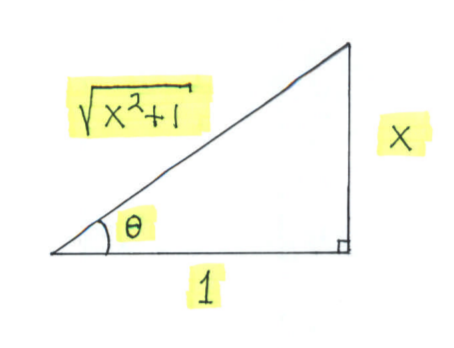SOLUTION 8: $ \ \ $ To integrate $ \displaystyle{ \int {
\sqrt{x^2+1} \over x^2 } \ dx } $ use the trig substitution
$$ x = \tan \theta $$
so that
$$ dx = \sec^2 \theta \ d \theta $$
Substitute into the original problem, replacing all
forms of x, getting
$$ \displaystyle { \int \frac{\sqrt{x^{2}+1}}{x^{2}} \ dx = \int
\frac{\sqrt{ \tan^{2} \theta + 1}}{ \tan^{2} \theta} \cdot \sec^2 \theta \ d \theta } $$
$$ = \displaystyle { \int \frac{\sqrt{ \sec^{2} \theta }}{ \tan^{2} \theta} \cdot
\sec^2 \theta \ d \theta } $$
$$ = \displaystyle { \int \frac{ \sec \theta}{ \tan^{2} \theta} \cdot \sec^2 \theta \ d \theta } $$
$$ = \displaystyle { \int \frac{ \sec \theta}{ \tan^{2} \theta} (1 + \tan^2 \theta) \ d \theta } $$
$$ = \displaystyle { \int \Big( \frac{ \sec \theta }{ \tan^{2} \theta } + \sec \theta \Big) \ d \theta } $$
$$ = \displaystyle { \int \Bigg( \frac{ 1 \ \Big/\cos \theta }{ \sin^2 \theta \ \Big/\cos^{2} \theta } + \sec \theta \Bigg) \ d \theta } $$
$$ = \displaystyle { \int \Big( \frac{ 1 }{ \cos \theta }\frac{ \cos^{2} \theta}{\sin^2 \theta } + \sec \theta \Big) \ d \theta } $$
(Recall that $ \displaystyle { \int \sec \theta \ d \theta = \ln \Big|\sec \theta + \tan \theta \Big| + C } . $)
$$ = \displaystyle { \int \frac{ \cos \theta}{\sin^2 \theta } \ d \theta } + \ln \Big|\sec \theta + \tan \theta \Big| + C $$
$$ = \displaystyle { \int \frac{ 1 }{ \sin \theta } \frac{ \cos \theta }{ \sin \theta } \ d \theta } + \ln \Big|\sec \theta + \tan \theta \Big| + C $$
$$ = \displaystyle { \int { \csc \theta }{ \cot \theta } \ d \theta } + \ln \Big|\sec \theta + \tan \theta \Big| + C $$
(Recall that $ \displaystyle{ \int \csc \theta \cot \theta \ d \theta = -\csc \theta + C } $ .)
$$ = -\csc \theta + \ln \Big|\sec \theta + \tan \theta \Big| + C $$
$ \Big( $ We need to write our final answer in terms of $x$.

Since $ x = \tan \theta $ it follows that
$$ \tan \theta = \displaystyle{ x \over 1 } = \displaystyle{ opposite \over adjacent } $$
and from the Pythagorean Theorem that
$$ \displaystyle (adjacent)^2 + (opposite)^2 = (hypotenuse)^2
\ \ \longrightarrow $$
$$ (1)^2 + (x)^2 = (hypotenuse)^2
\ \ \longrightarrow \ \ \ hypotenuse = \sqrt{x^2+1} \ \ \longrightarrow $$
$$ \csc \theta = \displaystyle{ hypotenuse \over opposite }= \displaystyle{ \sqrt{x^2+1} \over x } $$
and
$$ \sec \theta = \displaystyle{ hypotenuse \over adjacent }= \displaystyle{ \sqrt{x^2+1} \over 1 } = \sqrt{x^2+1} . \Big) $$
$$ = -\displaystyle{ \sqrt{x^2+1} \over x } + \ln \Big|\sqrt{x^2+1} + x \Big| + C $$
Click HERE to return to the list of problems.

